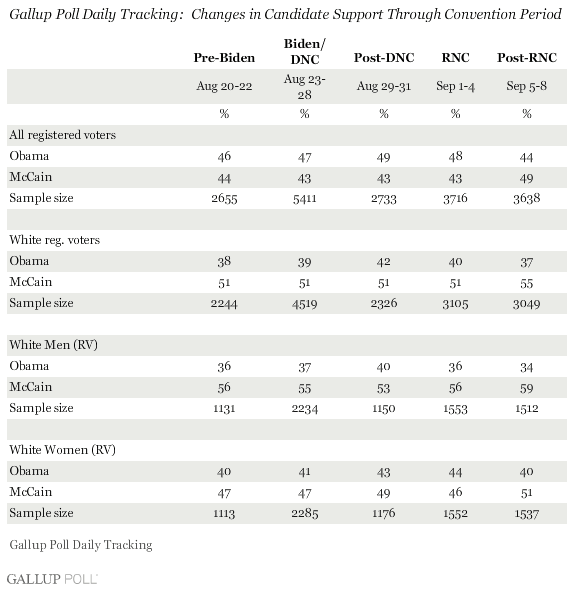PRINCETON, NJ -- An analysis of Gallup Poll Daily tracking interviewing conducted before and after the two major-party conventions shows that the impact of the conventions was not materially different for white women than it was for white men, and neither group's shifts were substantially different than the changes among the overall electorate.

These conclusions are based on comparisons of very large samples of Gallup Poll Daily tracking interviews conducted at intervals before, during, and after the two conventions. In general, the comparison shows only a modest change in vote patterns, with white women shifting in the same broad ways as the overall sample average.
Just before the Democratic National Convention (in Gallup Poll Daily tracking interviewing from Aug. 20-22), white women broke 47% to 40% in favor of McCain over Obama. In interviewing from Sept. 5-8, after both conventions were completed, white women's margin of support for McCain over Obama edged up modestly to 51% to 40%. This represents a gain of four percentage points for McCain among white women and no change in their support for Obama.
Among white men, the change in preference for McCain was very similar to the change among white women, coupled with a slight loss of support for Obama. White men went from 56% to 36% support for McCain over Obama to a 59% to 34% split now.
More generally, the data show that McCain gained four points among all white voters (both men and women), and Obama lost one point.
(For all voters, regardless of race or gender, the race shifted from a 46% to 44% advantage for Obama in Aug. 20-22 polling to a 49% to 44% advantage for McCain after the conventions. That's a gain of five points for McCain and a loss of two for Obama.)
In short, it appears that the impact of the two conventions was not materially different for white women than it was for white men, and neither group's shifts were substantially different than the changes among the overall electorate. Among all groups, McCain gained during the time period encompassing the two conventions, and Obama was roughly stable.
Despite the intense focus on the potential impact on white women of McCain's selection of Sarah Palin as his vice presidential running mate, the Gallup data do not show that to this point white women have been significantly different in their response to the convention period than has the average voter.
Survey Methods
Results are based on telephone interviews conducted between August 20 and September 8, 2008, as part of the Gallup Poll Daily Tracking Survey, for which Gallup is interviewing no fewer than 1,000 U.S. adults nationwide each day during 2008.
Interviews reported here are based on registered voters, aged 18 and older. The sample sizes for each time period analyzed in this analysis are displayed in the table above. The margin of sample error varies for each of these groups, but in all cases, one can say with 95% confidence that the maximum margin of sampling error is ±3 percentage points or less.
Interviews are conducted with respondents on land-line telephones (for respondents with a land-line telephone) and cellular phones (for respondents who are cell-phone only).
In addition to sampling error, question wording and practical difficulties in conducting surveys can introduce error or bias into the findings of public opinion polls.
To provide feedback or suggestions about how to improve Gallup.com, please e-mail feedback@gallup.com.
